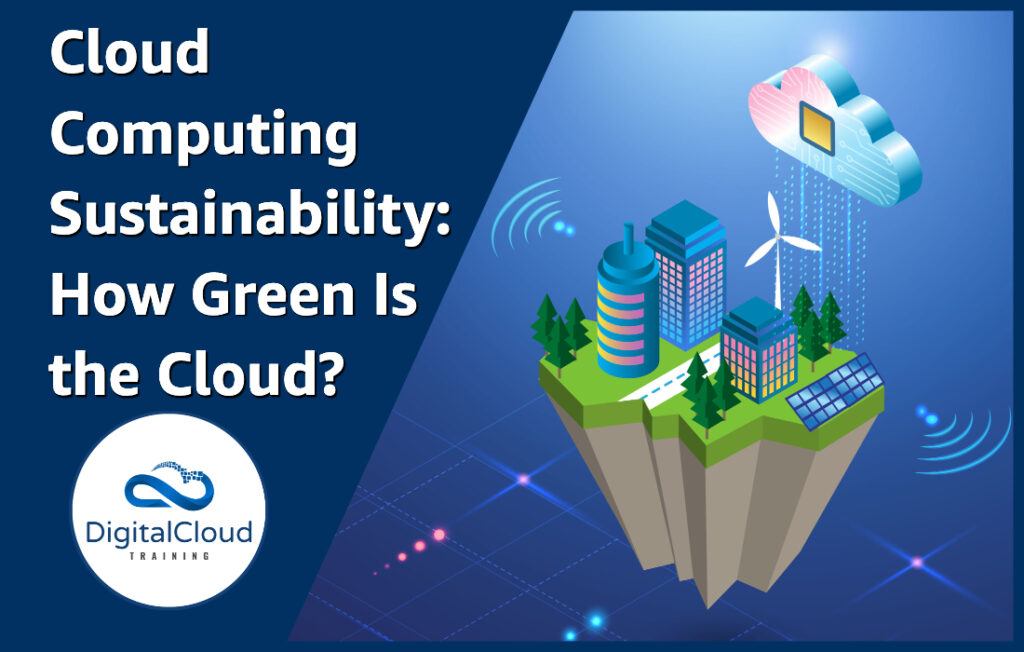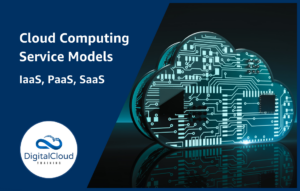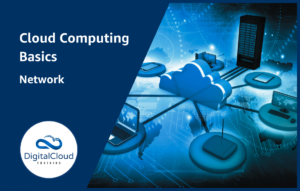Cloud Computing Sustainability: How Green Is the Cloud?
Please use the menu below to navigate the article sections:

Cloud computing sustainability or ‘Green Cloud’ refers to an environment-friendly cloud that reduces carbon emissions and promotes the use of renewable energy to reduce energy needs. All the major cloud providers have taken steps to convert their data centres into green cloud. AWS’s sustainability pillar is one example of how Amazon promotes an environment-friendly cloud.
What is Green Cloud Computing?
Green cloud computing is a set of beneficial practices which reduce energy consumption and carbon emissions. Green computing advocates the use of renewable energy from different sources. It has three main goals:
- Maximizing energy efficiency
- Promoting recycling
- Minimizing the use of hazardous materials
How does Green Cloud Computing Work?
Cloud providers employ different techniques and processes which result in greener data centers. Here are some of these techniques:
Renewable Energy Source
Cloud providers use renewable energy sources to reduce the power needs of data centres. These sources include solar, wind, hydropower, and huge battery banks for storing the collected energy. Some cloud vendors use renewable energy credits to balance their carbon footprint.
Optimizing the Facility
Cloud providers take many steps to ensure reduced energy consumption in their data centres. Cloud vendors, especially tech giants, use AI and machine learning-based techniques to monitor and suggest optimized energy use. That includes optimizing the architecture, floor layouts, and location of the data centre to optimize energy consumption.
Other steps include:
- Utilize excessive heat produced by the data centres to warm nearby buildings
- Place the data centre in a cold climate, underground or even in the ocean
Optimizing the Infrastructure
Cloud infrastructure is a core element in energy consumption. Cloud providers use modern hardware, which consumes less energy. They also use hardware that utilizes different energy-saving techniques like dynamic voltage and frequency scaling. Similarly, applying different techniques to maximize resource utilization, including virtualization and containerization, results in fewer servers and reduced energy consumption.
Optimizing the Workflow
Cloud providers also apply techniques to optimize the workflow to minimize energy consumption. Some of the techniques are:
- Dividing the workload across different servers intelligently to maximize resource utilization
- Optimizing network routes to reduce network traffic
- Optimizing portable storage and server caching to reduce network calls
- Automating routine tasks to save time and energy
Objectives of Green Cloud Computing
The main goals of green computing are:
- Minimize the use of hazardous materials
- Maximize energy efficiency
- Better biodegradability of products
Let’s learn about these green computing objectives in more detail.
Recycling
Recycling aims to eliminate e-waste. E-waste should be recycled or reused. E-waste includes retired, expired, and non-functional electronic gadgets, including PC, laptops, mobile phones, etc. The devices are made of metals like copper and lead, which are hazardous. When the age of these metals is expired, they are thrown away. Recycling these components can minimize the drastic impact on the environment. Green computing promotes adopting practices that will facilitate the recycling and reuse of e-waste.
Reduce Cost
One of the major objectives of green computing is to save costs. Cloud vendors reduce infrastructure costs as compared to on-premise infrastructure. Cloud computing gives you different cloud utilization strategies, and you can opt for the best one that suits your needs. Using the right cloud services, you can reduce your energy requirements and have better workload flexibility. Cloud vendors use the latest hardware, which is energy and cost-efficient. The intelligent utilization of resources is one of the main features of modern cloud vendors. You will be spending more resources and costs if you use on-premise infrastructure.
Help Companies meet their Sustainability Goals
One of the essential goals of green computing is to enable companies to achieve their sustainability goals. On-premise data centres consume more energy and increase the emission of harmful gases like carbon dioxide. Moving to cloud computing help companies cut down their energy requirements and achieve sustainable growth. Green cloud data centres can save up to 629 million metric tons of greenhouse gases by 2025.
Remote Work Capabilities
Another important objective of green computing is facilitating remote and hybrid work culture. Remote work allows companies to use smaller office spaces and reduces the infrastructure needs of employees. Similarly, employees do not need to commute to the office, which reduces the use of vehicles and hence cuts down on the emission of greenhouse gases. Note that remote and hybrid work culture also provides flexibility to employees, which improves their productivity.
Virtualization and Containerization
Green computing also aims towards virtualization. Virtualization reduces the overall power consumption needs. It minimizes the number of servers needed and promotes virtual infrastructure. When the number of servers is reduced, the data centre’s size is also minimized. Virtualization also minimizes downtime because virtualization allows you to balance workload across different server groups. Containerization is also a modern technique that aims to reduce hardware needs. Containerization reduces the carbon footprint and reduces the number of servers needed in a data centre.
Why Is Cloud Computing Environmentally Sustainable?
Here’s how Cloud computing supports sustainability:
Higher Utilization Rate
Using on-premise data centres results in a low utilization rate because you over-provision the infrastructure to handle unexpected workloads. Cloud computing can make intelligent use of servers at high utilization rates with increased efficiency. Public cloud infrastructure is usually 2-4 times more efficient than traditional data centres due to better infrastructure utilization.
Reduce Electricity Needs
On-premise infrastructure needs high maintenance and requires UPS, electricity, cooling systems, etc. Moving your software to the cloud will save significant electricity. As claimed by the case study of Lawrence Berkeley National Laboratory, moving business applications like CRM, email, etc., to the cloud can save enough electricity each year to provide electricity needs for Los Angeles for one year. A similar study claims that moving to the cloud would save energy consumption by 87%.
Hardware Refresh Speed
Traditional data centre infrastructure is used for a long time before it is expired or replaced because of the high cost of upgrading servers. Due to a better utilization rate, cloud infrastructure is replaced much earlier. The new hardware is more energy efficient than its predecessor. The more energy efficient the hardware is, the more money cloud vendors will save. Eventually, less energy will be used in the long term.
Reduced Climate Impact
Cloud-based data centres reduce carbon emissions as compared to traditional data centres. According to Amazon, it uses 77% fewer servers, 84% less power, and utilizes a 28% cleaner power mix. This brings an overall reduction in carbon emissions of 88% compared to on-premise data centres.
Powered by Renewable Energy
Most cloud providers use renewable energy sources such as solar, wind, and hydropower, resulting in reduced or no greenhouse gases. Traditional fossil-based fuels account for more than 80% of global power consumption.
Better Infrastructure
Cloud-based data centres are usually located closer to facilities that provide electricity. This reduces the losses while transmitting electrical energy across large distances. On-premise data centres do not have that choice. Cloud providers are also equipped with better and latest hardware which uses less wattage to provide backup power and cooling for their data centres.
How to Migrate to Sustainable Green Cloud Computing?
Below are some of the essential steps which can lead to sustainable green cloud computing:
Virtualization and Containerization
Traditional data centers use excessive power. Migrating to virtualization and containerization can reduce your energy needs. Virtual machines and containers divide hardware into many portions, so multiple operating systems or applications can be deployed on a single server. As a result, fewer servers are needed and hence less energy is consumed. Virtual infrastructure provides many benefits, including instant failover, uniform resource distribution, and high server utilization.
Micro Data Centres
Miniature data centers are lightweight movable data centers that are distributed around the globe. They use less energy as they are lightweight and they are relatively small. They help in lowering reaction time which decreases downtime. They have built-in auto scaling capabilities and can be placed closer to the user’s location.
Adopting Rank-Based Microservices
If you are using a monolith application, then you should move to microservices-based architecture to promote green cloud computing. Different interconnected microservices are deployed across different cloud nodes. When microservices are deployed in containers (e.g. docker) and a rank-based profile is generated for microservices, less energy is consumed. The response time is also reduced because the containers and microservices are placed in the exact data center location.
AI-based Resource Scheduling
Efficient resource scheduling is one of the issues faced by many data centers. The goal is to make use of intelligent resource scheduling based on the diverse needs of different customers using that data center. Of course, the strategy of “one size fits all” does not work here. AI-based techniques can aid in the smart scheduling of resources so that they will allocate resources intelligently, resulting in less power consumption. Machine learning and deep learning can analyze the historical data of resource usage and predict the under-usage and over-usage of specific resources. AI techniques can generate leading metrics and forecasts related to resource usage so you can take necessary measures on time to preserve energy consumption.
Effective Infrastructure Utilization with IaaS
IaaS is a form of cloud computing where you use the infrastructure provided by the cloud. Using IaaS promotes green computing because you delegate the responsibility of infrastructure management to the cloud provider. Cloud providers make intelligent use of virtual machines and containers to reduce the number of servers needed at data centers. Energy consumption is also reduced when the number of servers and data centers is reduced. Serverless infrastructure also promotes green computing because you delegate the responsibility of the entire server management to the cloud vendors, who are adept at applying modern techniques of saving energy consumption.
Conclusion
Green cloud is an inevitable need for our environment. In this article, we discussed the goals of green computing and what steps can be taken to convert your traditional cloud to a green cloud. AWS has taken many steps towards green cloud computing and has introduced a sustainability pillar to its group of well-architected framework pillars. The sustainability pillar focuses on the environment-friendly cloud, aka ‘green cloud’. To understand and implement the best practices of the sustainability pillar for green cloud, AWS certifications are a great way to learn. Check out our AWS training that will help you achieve AWS certifications and equip you with in-depth skills and knowledge.
Learn how to Master the Cloud
AWS Training – Our popular AWS training will maximize your chances of passing your AWS certification the first time.
Membership – For unlimited access to our entire cloud training catalog, enroll in our monthly or annual membership program.
Challenge Labs – Build hands-on cloud skills in a secure sandbox environment. Learn, build, test and fail forward without risking unexpected cloud bills.





Responses